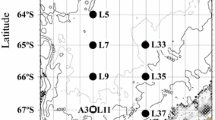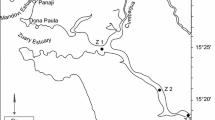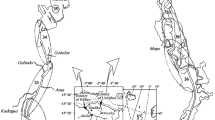Abstract
Zooplankton was sampled at ten stations in the Canada Basin during August 2002 using both 53- and 236-μm mesh nets to examine the contribution by smaller and less studied species. Copepod nauplii, the copepods Oithona similis, Oncaea borealis and Microcalanus pygmaeus, and the larvacean Fritillaria borealis typica dominated the upper 100 m of the water column numerically, while biomass was dominated by the copepods Calanus hyperboreus, Calanus glacialis and Paraeuchaeta glacialis, and the chaetognath Eukrohnia hamata. Zooplankton biomass ranged from 3.7 to 14.5 mg AFDW m−3, with a mean of 9.6 mg AFDW m−3 . While the three microcopepods contributed less than 5% of the biomass, estimates of their potential growth rates suggest they might contribute upwards of 25% of the metazoan zooplankton production. The true rates of growth and development of these microcopepods in the Arctic need to be determined to conclusively ascertain their importance.





Similar content being viewed by others
References
Acuna JL, Deibel D, Bochdansky AB, Hatfield E (1999) In situ ingestion rates of appendicularian tunicates in the Northeast Water Polynya (NE Greenland). Mar Ecol Prog Ser 186:149–160
Ashjian CJ, Smith SL, Lane PVZ (1995) The Northeast Water Polynya during summer 1992: distribution and aspects of secondary production of copepods. J Geophys Res 100:4371–4388
Ashjian CJ, Campbell RG, Welch HE, Butler M, Keuren DV (2003) Annual cycle in abundance, distribution, and size in relation to hydrography of important copepod species in the western Arctic Ocean. Deep Sea Res I 50:1235–1261
Auel H, Hagen W (2002) Mesozooplankton community structure, abundance and biomass in the central Arctic Ocean. Mar Biol 140:1013–1021
Auel H, Werner I (2003) Feeding, respiration and life history of the hyperiid amphipod Themisto libellula in the Arctic marginal ice zone of the Greenland Sea. J Exp Mar Biol Ecol 296:183–197
Brodsky KA (1983) Copepod Crustacea (Copepoda: Calanoida) of the seas of the USSR and adjacent waters (Part 1). Zoological Institute of the Academy of Sciences of the USSR, Leningrad
Chisholm LA, Roff JC (1990) Size–weight relationships and biomass of tropical neritic copepods off Kingston, Jamaica. Mar Biol 106:71–77
Conover RJ (1962) Metabolism and growth in Calanus hyperboreus in relation to its life cycle. Rapp PV Reun Cons Int Explor Mer 153:190–197
Conover RJ (1967) Reproductive cycle, early development, and fecundity in laboratory populations of the copepod Calanus hyperboreus. Crustaceana 13:61–72
Conover RJ, Huntley M (1991) Copepods in ice-covered seas—distribution, adaptations to seasonally limited food, metabolism, growth patterns and life cycle strategies in polar seas. J Mar Syst 2:1–41
Deibel D (1986) Feeding mechanism and house of the appendicularian Oikopleura vanhoeffeni. Mar Biol 93:429–436
Falkenhaug I, Sakshaug E (1991) Prey composition and feeding rate of Sagitta elegans var. arctica (Chaetognatha) in the Barents Sea in early summer. Polar Res 10:487–506
Fenaux R (1976) Cycle vital, croissance et production chez Fritillaria pellucida (Appendicularia), dans la baie de Villefranche-sur-Mer, France. Mar Biol 34:229–238
Fenaux R (1998) Life history of the Appendicularia. In: Bone Q (ed) The biology of pelagic tunicates. Oxford University Press, New York, pp 151–159
Gorsky G, Fenaux R (1998) The role of Appendicularia in marine food chains. In: Bone Q (ed) The biology of pelagic tunicates. Oxford University Press, New York, pp 161–169
Hirche H-J (1997) Life cycle of the copepod Calanus hyperboreus in the Greenland Sea. Mar Biol 128:607–618
Hirche H-J, Niehoff B (1996) Reproduction of the Arctic copepod Calanus hyperboreus in the Greenland Sea—field and laboratory observations. Polar Biol 16:209–219
Hirche H-J, Hagen W, Mumm N, Richter C (1994) The Northeast Water Polyna, Greenland Sea. III. Meso- and macrozooplankton distribution and production of dominant herbivorous copepods during spring. Polar Biol 14:491–503
Hirst AG, Bunker AJ (2003) Growth of marine planktonic copepods: global rates and patterns in relation to chlorophyll a, temperature, and body weight. Limnol Oceanogr 48:1988–2010
Hirst AG, Lampitt RS (1998) Towards a global model of in situ weight-specific growth in marine planktonic copepods. Mar Biol 132:247–257
Hopcroft RR, Roff JC, Bouman HA (1998) Zooplankton growth rates: the larvaceans Appendicularia, Fritillaria and Oikopleura in tropical waters. J Plankton Res 20:539–555
Hopcroft RR, Roff JC, Chavez FP (2001) Size paradigms in copepod communities: a re-examination. Hydrobiologia 453/454:133–141
Hopcroft RR, Clarke C, Chavez FP (2002) Copepod communities in Monterey Bay during the 1997 to 1999 El Niño and La Niña. Prog Oceanogr 54:251–263
Hopkins TL (1969) Zooplankton standing crop in the Arctic Basin. Limnol Oceanogr 14:80–85
Huntley ME, Lopez MDG (1992) Temperature-dependent production of marine copepods: a global synthesis. Am Nat 140:201–242
Ikeda T, Shiga N (1999) Production, metabolism and production/biomass (P/B) ratio of Themisto japonica (Crustacea: Amphipoda) in Toyama Bay, southern Japan Sea. J Plankton Res 21:299–308
Kiørboe T, Sabatini M (1994) Reproductive and life cycle strategies in egg-carrying cyclopoid and free-spawning calanoid copepods. J Plankton Res 16:1353–1366
Kosobokova KN (1980) Seasonal variations in the vertical distribution and age composition of Microcalanus pygmaeus, Oithona similis, Oncaea borealis and O. notopus populations in the central Arctic basin. Biologiya Tsentral’nogo Arkicheskogo Basseyna. Nauka, Moscow, pp 167–182
Kosobokova KN (1982) Composition and distribution of the biomass of zooplankton in the central Arctic Basin. Oceanology 22:744–750
Kosobokova KN (1999) The reproductive cycle and life history of the Arctic copepod Calanus glacialis in the White Sea. Polar Biol 22:254–263
Kosobokova KN, Hirche H-J (2000) Zooplankton distribution across the Lomonosov Ridge, Arctic Ocean: species inventory, biomass and vertical structure. Deep Sea Res I 47:2029–2060
Kosobokova KN, Hanssen H, Hirche H-J, Knickmeier K (1998) Composition and distribution of zooplankton in the Laptev Sea and adjacent Nansen Basin during summer, 1993. Polar Biol 19:63–73
Matthews JBL, Hestad L (1977) Ecological studies on the deep-water pelagic community of Korsfjorden, Western Norway. Length/weight relationships for some macroplanktonic organisms. Sarsia 63:57–63
McLaren IA (1969) Population and production ecology of zooplankton in Ogac Lake, a landlocked fjord on Baffin Island. J Fish Res Bd Can 26:1485–1559
McLaughlin F, Shimada K, Carmack E, Ito M, Nishino S (2004) The hydrography of the deep Canada Basin, 2002. Polar Biol (in press)
Mumm N (1991) On the summerly distribution of mesozooplankton in the Nansen Basin, Arctic Ocean (in German). Rep Polar Res 92:1–173
Mumm N (1993) Composition and distribution of mesozooplankton in the Nansen Basin, Arctic Ocean, during summer. Polar Biol 13:451–461
Mumm N, Auel H, Hanssen H, Hagen W, Richter C, Hirche H-J (1998) Breaking the ice: large-scale distribution of mesozooplankton after a decade of Arctic and transpolar cruises. Polar Biol 20:189–197
Nielsen TG, Møller EF, Satapoomin S, Ringuette M, Hopcroft RR (2002) Egg hatching rate of the cyclopoid copepod Oithona similis in arctic and temperate waters. Mar Ecol Prog Ser 236:301–306
Pautzke CG (1979) Phytoplankton primary production below Arctic Ocean pack ice: an ecosystem analysis. PhD Oceanography, University of Washington
Quinones RA, Platt T, Rodríguez J (2003) Patterns of biomass-size spectra from oligotrophic waters of the Northwest Atlantic. Prog Oceanogr 57:405–427
Raskoff KA, Purcell JE, Hopcroft RR (2004) Gelatinous zooplankton of the Arctic Ocean: in situ observations under the ice. Polar Biol DOI 10.1007/s00300-004-0377
Richter C (1994) Regional and seasonal variability in the vertical distribution of mesozooplankton in the Greenland Sea. Rep Polar Res 154:1–87
Roff JC, Hopcroft RR (1986) High precision microcomputer based measuring system for ecological research. Can J Fish Aquat Sci 43:2044–2048
Sabatini M, Kiørboe T (1994) Egg production, growth and development of the cyclopoid Oithona similis. J Plankton Res 16:1329–1351
Shiga N (1976) Maturity stages and relative growth of Oikopleura labradoriensis Lohmann (Tunicata, appendicualria). Bull Plankton Soc Jpn 29:119–128
Sirenko BI (2001) List of species of free-living invertebrates of Eurasian Arctic Seas and adjacent deep waters. Russian Academy of Sciences, St. Petersburg
Smith SL, Schnack-Scheil SB (1990) Polar zooplankton polar oceanography part B: chemistry biology and geology. Academic, San Diego, pp 527–598
Sturm M, Perovich DK, Serreze MC (2003) Meltdown in the North. Sci Am 289:60–67
Thibault D, Head EJH, Wheeler PA (1999) Mesozooplankton in the Arctic Ocean in summer. Deep Sea Res 46:1391–1415
Unstad KH, Tande KS (1991) Depth distribution of Calanus finmarchicus and C. glacialis to environmental conditions in the Barents Sea. In: Sakshaug E, Hopkins CCE, Øslashritsland NA (eds) Proceedings of the Pro Mare symposium on polar marine ecology. Polar Res 10:409–420
Welch HE, Siferd TD, Bruecker P (1996) Population densities, growth, and respiration of the chaetognath Parasagitta elegans in the Canadian High Arctic. Can J Fish Aquat Sci 53:520–527
Yamaguchi A, Ikeda T (2000) Vertical distribution, life cycle and body allometry of two oceanic calanoid copepods (Pleuromamma scutullata and Heterorhabdus tanneri) in the Oyashio region, western North Pacific Ocean. J Plankton Res 22:29–46
Acknowledgements
We wish to thank F. McLaughlin and K. Crane for accommodating our sampling needs during an otherwise over-committed JWACS/NOAA-OE cruise on the CCGS Louis St. Laurent. S. Toews was invaluable in providing sampling support. This research was supported by the Ocean Exploration Office of the National Oceanic and Atmospheric Administration (NOAA) under award NA16RP2625.
Author information
Authors and Affiliations
Corresponding author
Rights and permissions
About this article
Cite this article
Hopcroft, R.R., Clarke, C., Nelson, R.J. et al. Zooplankton communities of the Arctic’s Canada Basin: the contribution by smaller taxa. Polar Biol 28, 198–206 (2005). https://doi.org/10.1007/s00300-004-0680-7
Received:
Revised:
Accepted:
Published:
Issue Date:
DOI: https://doi.org/10.1007/s00300-004-0680-7




